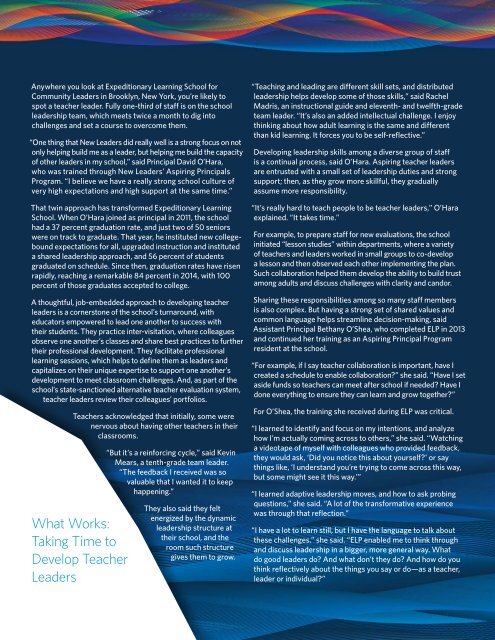NewLeaders_Untapped
NewLeaders_Untapped
NewLeaders_Untapped
You also want an ePaper? Increase the reach of your titles
YUMPU automatically turns print PDFs into web optimized ePapers that Google loves.
Anywhere you look at Expeditionary Learning School forCommunity Leaders in Brooklyn, New York, you’re likely tospot a teacher leader. Fully one-third of staff is on the schoolleadership team, which meets twice a month to dig intochallenges and set a course to overcome them.“One thing that New Leaders did really well is a strong focus on notonly helping build me as a leader, but helping me build the capacityof other leaders in my school,” said Principal David O’Hara,who was trained through New Leaders’ Aspiring PrincipalsProgram. “I believe we have a really strong school culture ofvery high expectations and high support at the same time.”That twin approach has transformed Expeditionary LearningSchool. When O’Hara joined as principal in 2011, the schoolhad a 37 percent graduation rate, and just two of 50 seniorswere on track to graduate. That year, he instituted new collegeboundexpectations for all, upgraded instruction and instituteda shared leadership approach, and 56 percent of studentsgraduated on schedule. Since then, graduation rates have risenrapidly, reaching a remarkable 84 percent in 2014, with 100percent of those graduates accepted to college.A thoughtful, job-embedded approach to developing teacherleaders is a cornerstone of the school’s turnaround, witheducators empowered to lead one another to success withtheir students. They practice inter-visitation, where colleaguesobserve one another’s classes and share best practices to furthertheir professional development. They facilitate professionallearning sessions, which helps to define them as leaders andcapitalizes on their unique expertise to support one another’sdevelopment to meet classroom challenges. And, as part of theschool’s state-sanctioned alternative teacher evaluation system,teacher leaders review their colleagues’ portfolios.Teachers acknowledged that initially, some werenervous about having other teachers in theirclassrooms.What Works:Taking Time toDevelop TeacherLeaders“But it’s a reinforcing cycle,” said KevinMears, a tenth-grade team leader.“The feedback I received was sovaluable that I wanted it to keephappening.”They also said they feltenergized by the dynamicleadership structure attheir school, and theroom such structuregives them to grow.“Teaching and leading are different skill sets, and distributedleadership helps develop some of those skills,” said RachelMadris, an instructional guide and eleventh- and twelfth-gradeteam leader. “It’s also an added intellectual challenge. I enjoythinking about how adult learning is the same and differentthan kid learning. It forces you to be self-reflective.”Developing leadership skills among a diverse group of staffis a continual process, said O’Hara. Aspiring teacher leadersare entrusted with a small set of leadership duties and strongsupport; then, as they grow more skillful, they graduallyassume more responsibility.“It’s really hard to teach people to be teacher leaders,” O’Haraexplained. “It takes time.”For example, to prepare staff for new evaluations, the schoolinitiated “lesson studies” within departments, where a varietyof teachers and leaders worked in small groups to co-developa lesson and then observed each other implementing the plan.Such collaboration helped them develop the ability to build trustamong adults and discuss challenges with clarity and candor.Sharing these responsibilities among so many staff membersis also complex. But having a strong set of shared values andcommon language helps streamline decision-making, saidAssistant Principal Bethany O’Shea, who completed ELP in 2013and continued her training as an Aspiring Principal Programresident at the school.“For example, if I say teacher collaboration is important, have Icreated a schedule to enable collaboration?” she said. “Have I setaside funds so teachers can meet after school if needed? Have Idone everything to ensure they can learn and grow together?”For O’Shea, the training she received during ELP was critical.“I learned to identify and focus on my intentions, and analyzehow I’m actually coming across to others,” she said. “Watchinga videotape of myself with colleagues who provided feedback,they would ask, ‘Did you notice this about yourself?’ or saythings like, ‘I understand you’re trying to come across this way,but some might see it this way.’”“I learned adaptive leadership moves, and how to ask probingquestions,” she said. “A lot of the transformative experiencewas through that reflection.”“I have a lot to learn still, but I have the language to talk aboutthese challenges,” she said. “ELP enabled me to think throughand discuss leadership in a bigger, more general way. Whatdo good leaders do? And what don’t they do? And how do youthink reflectively about the things you say or do—as a teacher,leader or individual?”UNTAPPED | 29


